From Russia with Love (or at least a ring): Kamchatka Great Knot reaches the Arabian Gulf!
Guest blog by Dmitry Dorofeev & Oscar Campbell
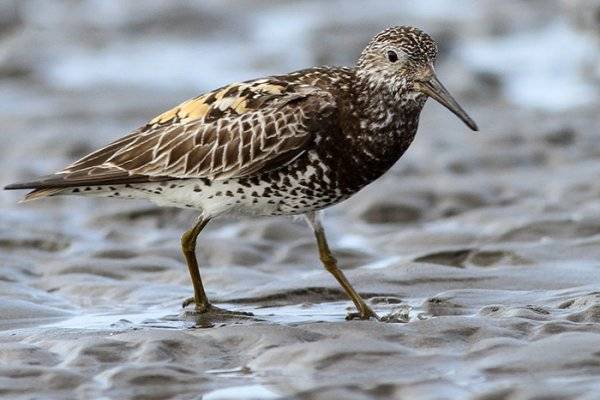
There are several sites along the Okhotsk Sea where waders make their first stopovers before their southward migration. For the last several years our group have worked on the largest known wader stopover on the western coast of Kamchatka peninsula, in the estuary Khairusova-Belogolovaya river.
A large wader stopover forms at this estuary from the end of June until the middle of September each year and some birds remain into early October. In total 32 wader species have been observed in the area. Some species recorded, for example, Spoon-billed Sandpiper, Far-Eastern Curlew and Great Knot are endangered. Field work has focused on the long-distance migrants – in particular Great and Red Knots, Black-tailed and Bar-tailed Godwits. These species are very vulnerable due to mudflat reclamation further south at key stopovers in Bohai Bay, China and South Korea. The western coast of Kamchatka is remote and pristine but not well studied by ornithologists. When this study started, there was very little data about this area – several sentences in one large book and small abstract from a local conference. After preliminary studies in 2011-2012, a first article about this area was published (Dorofeev & Kazansky, 2013)
Total numbers of waders utilizing the site vary from year to year and during peak migration up to 28,000 waders have been counted. The most common species are Great Knots (up to 23,000) and Black-tailed Godwits (up to 8,000).
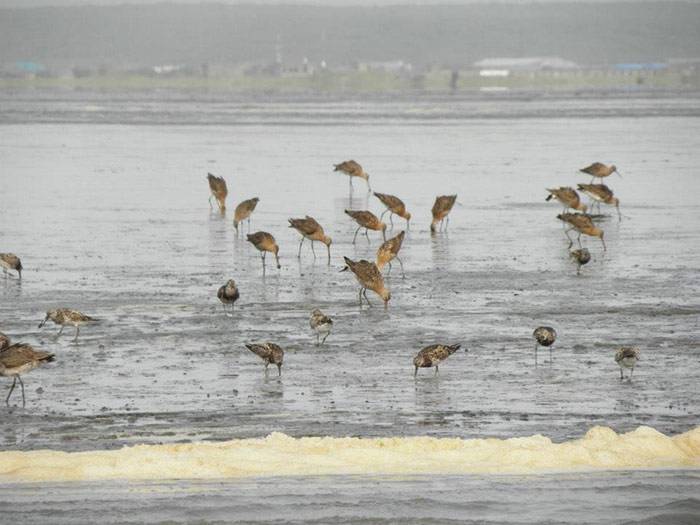
Great Knot and Black-tailed Godwits on the Khairusova-Belogolovaya River, Russia
During the last two seasons, wader counts have been completed, benthos samples taken, a ringing program initiated and as many resightings as possible made. There have been about 2,000 resightings of banded Great Knots and Black-tailed Godwits from about 25 ringing and observation sites along entire East Asian-Australasian Flyway as far away as New Zealand and Darwin. Based on this data it is now known that a significant proportion of birds stay in the area for several days or even up to one month. Birds forage on mudflats that are rich with different benthos species. In particular, Great Knots and Black-tailed Godwits prefer the small bivalve Macoma balthica.
In the 2016 field season some 320 Great Knots and 60 Black-tailed Godwits were marked with black upper and yellow lower engraved flags. Flags were attached to left tibia. There have already been some 30 resightings from Japan, Korea and Australia. One Red Knot banded in the same program reached New Zealand and one Great Knot that was firstly observed in Japan (17.09.2016) was then located in Northern Australia (27.01.2017).
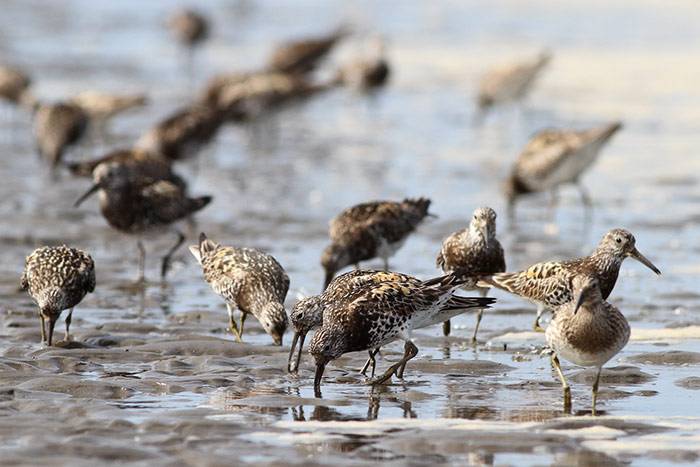
Great Knot on the Khairusova-Belogolovaya River, Russia
But the most interesting and unexpected resighting has recently come from an estuary on Arabian Gulf coast of the United Arab Emirates. Of course, the UAE is home to the Mohammed bin Zayed Conservation Fund, an organization which part-funded the work. On 20 January 2017, Great Knot EI was located and photographed amongst a small flock of 20 Great Knots, in the company of Bar-tailed Godwits (the usual companion species in the Middle East) and even a few Crab Plovers at Khor al Beida, some 8300km from the Kamchatka ringing location. It had been ringed here on 28 July 2016 and was seen again on 11 August. This resighting is of particular interest as it is the first confirmation obtained that Great Knots staging in Kamchatka reach as far west as the Arabian Gulf.
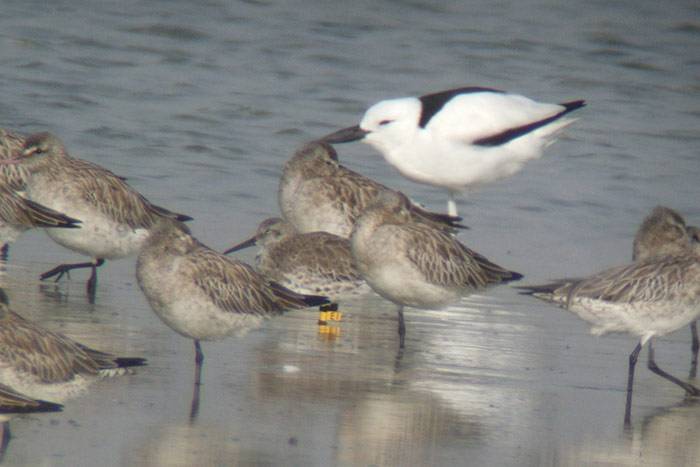
Great Knot E1 at Khor al Beida, UAE on 20 January 2017
There is still much to learn regarding the status of Great Knot in the Arabian Gulf. Khor al Beida, 45 minutes north of Dubai, is one of only a few easily accessible big estuarine sites in the UAE, and consequently well-watched. Since its discovery in the UAE in 1986, Great Knots have been recorded at Khor al Beida most winters, albeit in variable numbers (which are generally low; much less than 100 individuals). The majority of peak annual counts since 1990 have occurred in March, perhaps indicating some passage of birds that have wintered further west in the Arabian Gulf. A possible wintering location for such birds is the Marawah / Hail Shoals area, an offshore intertidal flat some 270km west south west of Khor al Beida where over 600 were counted in September 1994 but there have been very few ornithological records forthcoming since then from this very hard to access site. However, since 2013 small numbers have been discovered to regularly occur at Bhalghelam Island, 150km south west of Khor al Beida (Campbell & Hellyer, 2015). Khor al Beida came to prominence for the wrong reasons in April 2016 when large scale development plans are likely to substantially degrade the site were announced in the local press. Although scheduled to start in autumn 2016, no work has been initiated at the time of writing but the future of this wonderful wetland still hangs in the balance.
Acknowledgements
DD would like to thank all volunteers and specialists that have been involved in this project during the last two years. Field work has benefited greatly due to the input of ornithologists from Germany (Thomas Noah), South Korea (Hwajung Kim), Australia (Peter Crighton and Robert Bush), Great Britain (Richard Else and Hazel Watson) and Russia (Alexander Matzyna and Anna Ganiykova). The project would not have been possible without support from the All-Russian Research Institute for Environmental Protection (Russia), NIOZ (The Netherlands), The Mohammed bin Zayed Conservation Fund (United Arab Emirates), Oriental Bird Club, and the International and Australasian Wader Study Groups. OC thanks Sherrie and Chuck Karaian, visitors to the UAE, who joined him in the field for some wader-watching on 20 January 2017 and observed E1 at Khor al Beida.
Further reading
Campbell, O & Hellyer, P. 2015. A review of the status of Great Knot in the United Arab Emirates with , with comments on observations from a newly discovered wintering site. Tribulus 23: 107–110. Accessible at: http://www.uaebirding.com/Resources/Great%20Knot%20in%20the%20UAE.pdf
Dorofeev, DS & Kazansky, FV 2013. Post-breeding stopover sites of waders in the estuaries of the Khairusovo, Belogolovaya and Moroshechnaya rivers, western Kamchatka Peninsula, Russia, 2010–2012. Wader Study Group Bull. 120(2): 119–123.
Accessible at: http://www.waderstudygroup.org/article/1802/
Dmitry Dorofeev (Russia) & Oscar Campbell (UAE)
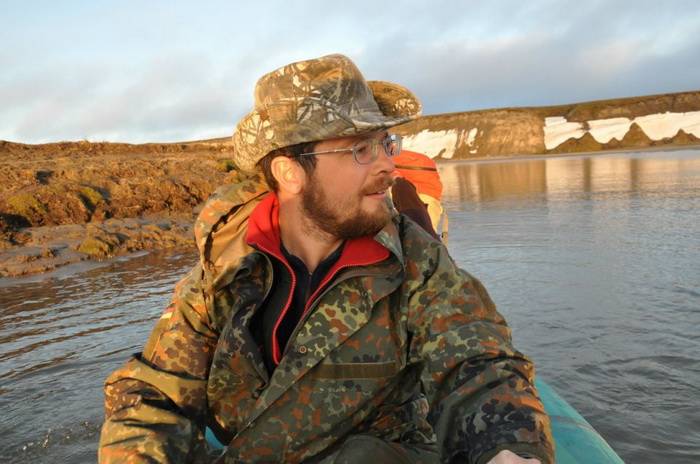
Dmitry Dorofeev is a researcher in All-Russian Research Institute for Environmental Protection and PhD student in Moscow State University. Nowadays, focusing on waders and geese studies.
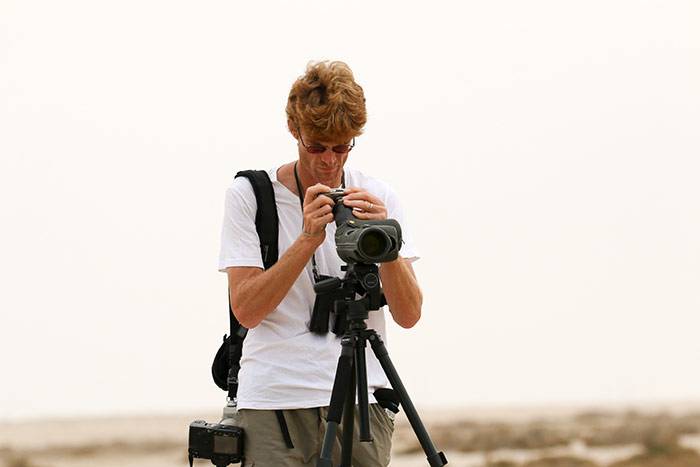
Oscar Campbell has been resident in the UAE since 2006 and watching birds for over 20 years prior to his migration there. He is chairman of the Emirates Bird Records Committee and, when not travelling in search of birds, teaches Chemistry in a school in Abu Dhabi.
